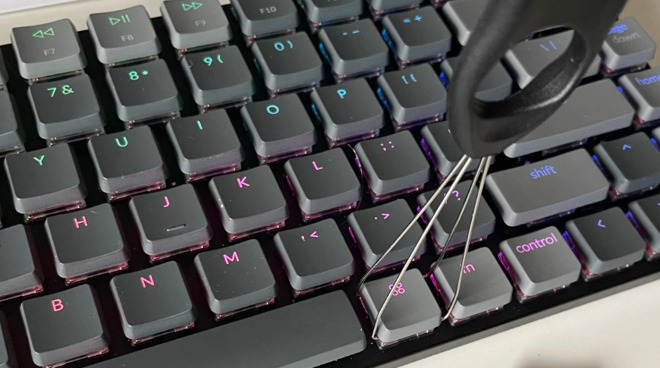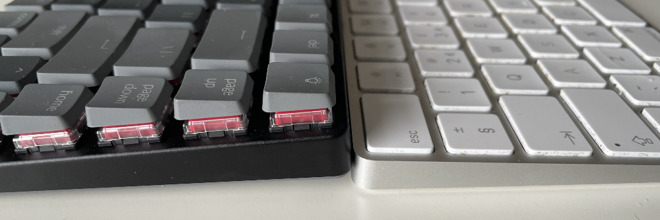The Keychron K3 is a particularly well-designed slimline mechanical keyboard, but its chief competition is other keyboards from the same manufacturer.

The Keychron K3 can feature hot-swappable keys
If you don't like mechanical keyboards, then the Keychron K3 is not going to change your mind -- but it might come close. It's larger than the kind of chiclet keyboard you get from Apple, yet slimline and small compared to most other mechanical ones.
Then if you do like mechanical keyboards, you're not going to lose any of the feel or the sound by going for this. It manages to be compact without any obviously overt compromise on the travel of the keys or the rigidity of the keyboard.
Keychron's latest keyboard follows its highly praised K2 predecessor, and the similarly rated K1 before it, in providing a solid, comfortable typing experience. Its predecessors are still available, though, and the addition of the Keychron K3 -- plus the forthcoming K4 -- means that it's tricky to choose.
What makes the K3 stand out is chiefly is business that it is built to be compact. It's compact enough that Keychron sells a separate travel pouch, plus a lightweight palm rest.

L: Keychron K3. R: Apple Magic Keyboard
Design -- switches and keys
Keychron describes this as an ultra-slim keyboard, and says that it is 75% of a full-size one. In practical use, it's visibly compact but not to the extent that it's noticeable when typing.
The sturdy aluminum body houses one of two types of key switches, an optical or a mechanical one. Either allows you to swap the keycaps to, for instance, make a Windows layout instead of a Mac one.
If it's hard to justify flashing backlight colors, it's also hard to dislike them
Keychron's low-profile optical switch version goes further and features hot-swappable caps and keys, meaning you can change both without switching off the keyboard.
Then for that optical switch version, there are six further options, each of which is claimed to be 40% slimmer than current regular switches.
These six switches include the best-known red and blue varieties, plus brown, white, black, and orange. This is really how mechanical keyboards get their flavor, as each type of switch produces a subtly different feel -- and sound.
Broadly, blue switches are loud, they need a firm press, and you can hear a distinct click as you type. Red switches are easier to press, needing less pressure, and tend to be quieter.
The others fall in between these two, and it is hard to accurately predict which will suit you the best. That said, though, they all make noise and require more typing pressure than the kind of chiclet keyboard that Apple sells.
This means that while there are these sometimes quite subtle differences, but overall you either like a mechanical keyboard or you don't. So if you like the sound and the harder typing pressure, you'll be happy whichever switch type you get.
AppleInsider tested red switches, and Keychron also supplied a full set of blue. You can buy blue or brown switches separately and swap out each key switch yourself, if you have the low-profile optical edition of the Keychron K3.
As well as being able to connect to three devices, switches on the back let you choose Bluetooth or cable connection, plus PC or Mac configurations.
Design -- backlighting and typing angle
What you can't do after purchase with any option is change the backlighting. You have to choose between a white backlight or what Keychron calls an RGB one.
This is a multi-colored backlight where, amongst many other options, you can have it that different color lights flash as you type. You can set one color to show all the time, too, or have moving patterns across the keys.
Backlighting isn't especially helpful when you're a touch typist, but even when you are, it is oddly restful having these colors play across the keys. If you dislike that, you can switch off the backlight -- or buy the White Backlight version instead.
Where you don't get any choice at all, though, is in the typing angle. The Keychron K3 comes with one angle, marked by both a slight slope on the keys, and double-height rubber feet at the rear.
In regular use, that angle is fine and the keyboard feels good. Moving to it from a low-lying Apple Magic Keyboard, though, takes some adjustment because your hands are best positioned slightly higher than the bottom row.
The separate palm rest helps elevate your hands to that level. Though note that it is a truly separate rest -- it does not connect to the keyboard and simply sits in front. This means that depending on the surface the rest is on, it can slip.
There's only one typing angle and the keyboard is taller than a standard Apple one, so this separately sold palm rest is useful
Keychron sells the palm rest separately. It comes in versions built to suit different Keychron keyboards, but all cost $25.
Switching keys
Keychron provides a tool for lifting keys, and switches, off the keyboard. The first time you do it, you do feel as if you're breaking off the keycap.
But then as soon as you've pressed a replacement into place, it is as if the new key was always there.
Removing a key or a key switch is particularly easy
There is more you can do besides changing layout to fit Windows or Mac. You can, for instance, decide against Keychron's default orange Escape key and replace it with a plain one.
What you can't do, though, is replace the US-style Enter key with, for instance, a European-style Return. Those keys are different shapes, and while Keychron sells many keyboards in these different configurations, the Keychron K3 is currently only available in the US style.
Perhaps more likely to affect your buying decision is how there's no option for a numeric keypad. That's obviously deliberate and part of making this a compact keyboard, but it would good to have an optional, separate keypad.
Should you buy the Keychron K3
At $74 for the white backlight version, and $84 for the multi-color RGB one, the Keychron K3 is an excellent keyboard for a good price. It has a very distinct feel, and sound, but it is compact enough for it to be truly portable.
Add to that how customizable it is with different keycaps, and even switches, and it is a particularly good buy -- if you like mechanical keyboards and don't want a numeric keypad.
Pros
- Compact design
- Enjoyable typing experience
- Able to switch quickly between multiple devices
- Can come with many backlighting options
- Picking the right switch for you is daunting
- No numeric keypad option
- Only one typing angle
Rating 5 out of 5
Where to buy
The Keychron K3 mechanical keyboard can be bought directly from Keychron's website, starting at $74 for the white backlight version.